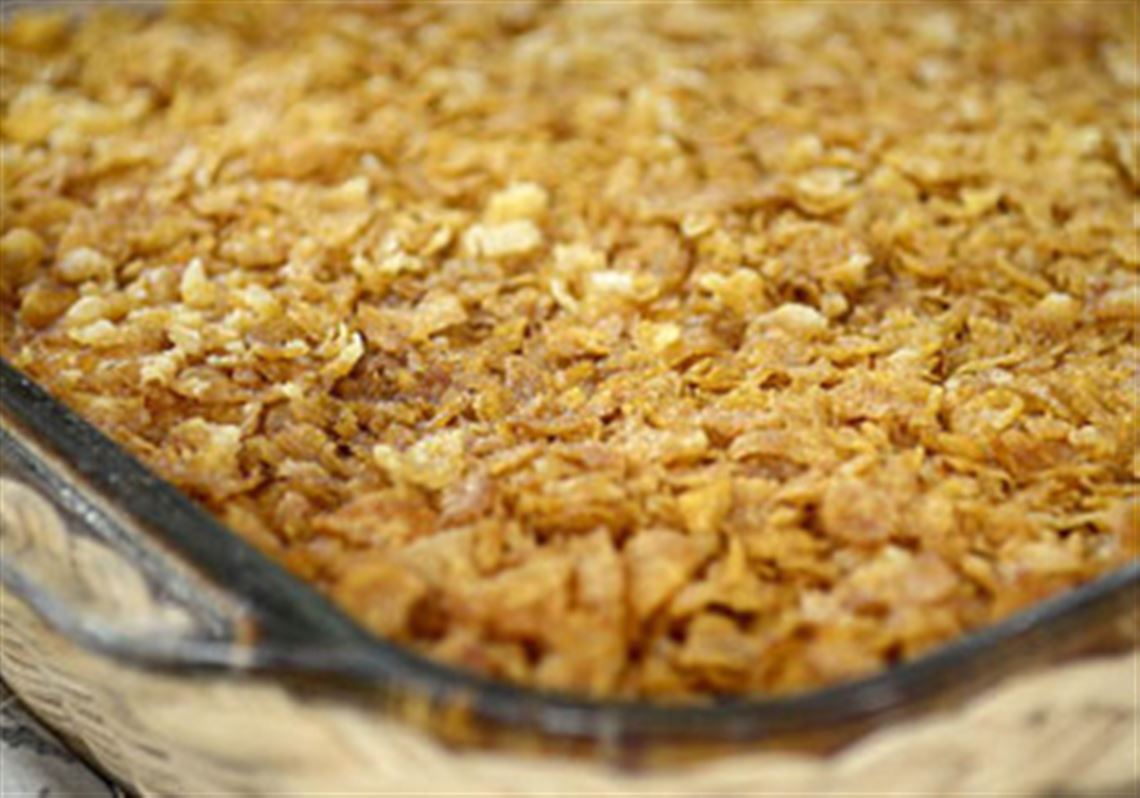Where do I begin to tell you about how I roasted a pig?
With the torrential rainstorm that threatened to douse the party I'd spent weeks planning, pummeling my backyard (and children) with so much water that my hair was still wet five hours later?
Or the fact that the power went out at exactly the moment I started cooking the barbecue sauce?
Honestly, what was most unnerving about our first annual PG Pig Roast was the pig. Until we picked the 61-pounder up from Thoma's Meat Market in Saxonburg, cooking a whole hog was very much an abstract idea, something to joke about.
"Who's gonna eat the eyeballs?" we teased the kids. Should we stuff an apple in its mouth? Think the trash guys will notice the head in the garbage can?
Watching the butcher pull the plastic-wrapped animal out of the cooler and load it with a grill onto our U-haul trailer, its red-tipped trotters sticking out of the folds like something on "Dexter,"was sobering. Suddenly there was no denying we were about to cook something that had just been grazing and rooting.
Tougher still was prepping the pig for the charcoal. I understood the carcass had been scalded and carefully scraped clean of hair, then slit along the backbone so it would lay flat on the grill. Still, I was ill-prepared for the smooth, bloodless-white skin and the long slice up the animal's belly. Even less so for the purple-red tongue, cut out of its mouth and hanging under its freckled snout like a glob of liver. When I caught sight of its baby blues, I screamed.
When I ordered the pig at the beginning of August (most butcher shops require at least a week's notice), I'd asked Brian Thoma if it had to come with its head. Well, no, he answered, clearly amused (or perhaps puzzled is a better description -- wasn't I a food writer?). "But that kind of takes away from it.
"Believe me, people will want the jowls and probably try the ears," he added. A brave few, he said, might even want to sample the eyes.
So what was I supposed to do with the head after the roast?
"Put it on a stick like 'Lord of the Flies' and freak out your neighbors?" suggested one Facebook friend.
Big Burrito executive chef Bill Fuller, who directed me to Mr. Thoma and served as Pig Roast Consultant in the days leading up to the event, had the best answer: "Have Peter deal with it. Duh." Isn't that what husbands are for?
Thanks to the directions from Thoma, roasting the pig was a breeze. Well, at least until the rainstorm hit. Terrified the charcoal would be extinguished, I dragged my three kids outside to help me hold a giant tarp over the grill. In a lightning storm.
In hindsight that was a pretty stupid idea. At the time, though, all that was running through my head was the fact I'd paid $2.69 a pound for the pig, plus another $40 to rent the grill. You can't cancel a pig roast.
Two hours later it was still pouring, but by then my husband was sloshing through the puddles with me in his suit pants, trying his best to hammer together a makeshift lean-to out of a stack of 2-by-4s. Eventually, a neighbor brought over a portable canopy along with a generator.
We didn't need it for long: within the hour, the sun was breaking through the clouds and the first guests arrived with a beautiful array of potluck salads, sides and desserts. Time to get this party started!
Cooks have been roasting whole pigs for thousands of years. But in the U.S., it's only been in the last few decades that it's become mainstream enough that regular Joes are hosting roasts in their backyards.
They're most popular in warm weather, starting in May with graduations and continuing through summer and fall at picnics, vacations and campouts, said Tom Friday, owner of Tom Friday's Market in Brighton Heights, one of several local butcher shops that provides whole pigs for roasts. You also can roast a pig in the cold of winter if the grill's sheltered, which is why deer hunters also are regular customers.
Even without the rain, I knew the process wouldn't be pretty (search Google images for "pig roast" and you'll see what I mean.) But would it really be as easy as putting a roast in the oven, as my butcher insisted?
"Because of the size, it does intimidate some people," said Mr. Friday. "But it's pretty hard to burn a pig because the skin is so rugged and durable."
And indeed, all we had to do, once the charcoal was white-hot, was lay the pig belly down on the grill and close the lid. A little over five hours later, we were noshing on the yummiest, most succulent nose-to-tail dish you can imagine.
"Once you've had it, you understand" why people throw pig roasts, agreed Mr. Friday. "It's really tasty pork."
Many who buy a whole pig (they're typically frozen) thaw it themselves over a drain in the garage, but I didn't want that responsibility or mess; we picked it up on the day of the roast already defrosted. Seeing most people pass on the cooked skin (it's like leather) it's also not necessary to shave off any stray hairs missed at the butcher shop before roasting, as Chef Fuller instructed.
While pigs easily can tip the scale at 100 pounds or more, the most popular size is around 80 pounds -- more than enough meat to feed around 50 people and still have leftovers. Some dig a pit or cook the pig on a spit, but I took the easy route and rented a charcoal grill from Mr. Thoma. Crafted from a 250-gallon oil drum, it took a forklift to lift it onto our U-haul trailer at the store and four strong men to get it back off again in our driveway.
If I did it, you can, too. Besides a grill and pig, here's all you need to get started: A level spot to position the pig roaster on top of cinderblocks, a pan to catch grease dripping from the drain, and charcoal and lighter fluid. (We used 70 pounds and three bottles for our 61-pound pig.)
Some like to cut slits in the skin and stuff it with a little garlic or rosemary, or season the entire body with salt and pepper, but it's really not necessary.
Absolutely essential is walking away after you close the lid. Each peek adds 15 minutes to the cooking time, and it really is impossible to go wrong if you follow the program: six hours for 80 to 100 pounds, seven hours for 100 to 125 pounds and eight to nine hours for a 150-pounder. When it's done, the internal temperature should read 170 degrees in the shoulder and hindquarters.
The most dramatic way to serve the pig, Mr. Thoma told me, is right off the grill. And to be sure, one hungry couple used their fingers to stuff the tender rib meat directly into their mouths. But that's messy and besides, I wanted the cooked pieces on my kitchen table, where it'd be easy to pull the meat from the bones with my fingers for sandwiches and tacos. No problem: all it took to hack it into quarters was a sharp chef's knife.
To my delight, a cheer went up when I lifted the first golden-brown section off the grates and onto a tray. A few minutes later, a giant platter of it lay shredded on the buffet table, with a bowl of homemade barbecue sauce. The crowed quickly dug in.
"This is sooo good," more than one guest exclaimed. Plates were loaded with seconds, and thirds. A few friends asked to take home leftovers.
Our big mistake was not cleaning the grill while it was still hot with a bucket of soapy water and an old broom, as instructed. A day-and-a-half later, the solidified grease in its belly was full of bees and even a wire brush couldn't scrape off the little bits of dried skin. We ended up having to light another fire to cook it off.
The smell that filled our backyard was so delicious that within minutes, my son was off the couch and on the deck. "Hey, are we doing another pig?" he shouted.
I didn't actually see him licking his lips, but I wouldn't have blamed him.
Quick homemade BBQ Sauce
PG tested
Great on chicken, too.
- 2 tablespoons olive oil
- 1 small yellow onion, finely diced (about 3/4 cup)
- 3/4 teaspoon kosher salt
- 1/2 teaspoon freshly ground black pepper
- 1/4 to 1/2 teaspoons chipotle powder or pimenton de la vera
- 1/2 cup ketchup
- 1/4 cup honey
- 1 tablespoon soy sauce
- 1 tablespoon cider vinegar
- 2 teaspoons Worchestershire sauce
- 1 teaspoon Liquid Smoke (optional)
Heat the oil and onion in a medium saucepan over medium-high heat until onion starts to sizzle steadily, about 1 minute. Reduce the heat to medium, sprinkle generously with salt and pepper, and cook, stirring, until the onion becomes translucent, about 4 more minutes. Sprinkle the chipotle powder on top and cook stirring until it becomes fragrant, about 30 seconds. Stir in the remaining ingredients and simmer for 5 minutes, so the flavors mix and meld and the onion becomes tender.
Using an immersion blender or by transferring sauce to a blender, puree until smooth. It will last in the refrigerator for up to 5 days.
Makes 11/4 cups sauce.
-- "Sear, Sauce and Serve" by Tony Rosenfeld (Running Press, 2011, $20)
Baked Beans in a cup
PG tested
These stovetop beans couldn't be easier, especially since I didn't make the bacon cups (too many people, too little time); I served them right out of the pot.
- 1 cup honey
- 1 fresh habanero chile, thinly sliced
- 1 tablespoon extra-virgin olive oil
- 1 large yellow onion, very finely chopped
- 2 1/2 cups canned navy beans, drained and rinsed
- 3/4 cup packed light-brown sugar
- 2 thick-cut bacon strips, finely chopped
- 1/4 cup port wine
- 3 tablespoons finely chopped fresh cilantro leaves
- 1 1/2 tablespoons dark molasses
- 1 teaspoon chili powder
- 2 teaspoons coarse salt
- Non-stick pan spray
- 2 pounds thin-cut bacon
- 2 mini-muffin pans
- 1/4 cup sour cream
- 1/4 cup finely chopped red and yellow bell pepper
- 2 scallions, white and light green parts, thinly sliced
Pour the honey into a small saucepan and bring to a simmer over medium heat. Turn off the heat and add the habanero and allow the honey to cool to room temperature. Strain through a fine-mesh sieve into an airtight container.
For the beans: Heat the olive oil in a medium pot over medium heat. Add the onions and cook until translucent, about 3 minutes. Add the beans, brown sugar, bacon, wine, cilantro, molasses and chili powder and 1 tablespoon of the habanero honey and salt. Stir to combine and bring to a simmer over medium heat. Reduce the heat to medium-low and simmer gently until the mixture is reduced by half, about 20 minutes. Turn off heat and set aside to cool to room temperature.
For the bacon cups: Preheat oven to 350 degrees. Turn muffin pan upside down and spray the bottom with cooking spray. Criss-cross 3 slices bacon over the upturned cup and then put another mini-muffin pan on top so bacon is compressed between the 2 pans. Place the pans on baking sheets and bake until bacon cups are crisp and brown, about 20 minutes. Remove the baking sheet from the oven and set aside to cool completely.
Lift up the top tin, carefully remove bacon cups and place on a paper towel to drain, wrong side up.
To serve: Gently reheat the beans over medium heat until warmed through. (Add 1 tablespoon water if they are too thick or dry.) Place a spoonful of beans into each bacon cup. Top with a dot of sour cream, some chopped pepper and scallion rings.
Both beans and bacon cups can be made 3 days in advance. Refrigerate beans in an airtight container and store bacon cups in airtight container at room temperature. Don't rewarm the bacon cups before serving or they'll go soft.
Makes 2 dozen.
-- "Bite by Bite: 100 Stylish Little Plates You Can Make for Any Party" by Peter Callahan with Raquel Pelzel (Clarkson Potter, 2011, $35)
Mary Peacock's Cheesy Potatoes
- 6 potatoes, parboiled until tender and sliced
- 2 teaspoons minced onion
- 12 tablespoons butter (1 1/2 sticks), divided
- 1 can cream of chicken soup
- 8-ounce carton sour cream
- 2 cups shredded cheddar cheese
- 1 clove garlic, minced
- Salt and pepper
- 2 cups corn flakes, crushed
Mix cooked potato and minced onion together in a large bowl. Melt 8 tablespoons butter, and add to bowl, tossing well.
Mix chicken soup and sour cream in a small bowl. Add to potatoes and stir to combine. Add cheddar and garlic, mix well and season with salt and pepper. Spoon into a large baking pan.
Melt remaining 4 tablespoons butter. Spread a layer of corn flakes on top of the potatoes. Drizzle with melted butter. Bake in a 350-degree oven for 45 minutes.
Makes 10 to 12 servings.
-- Amy Guest, Ben Avon
Spicy Grilled Pineapple Slaw
PG tested
- 3 limes, juiced plus more if needed
- 2 tablespoons vegetable oil
- 1 tablespoons agave nectar, plus more if needed
- 1 habanero chile, halved
- 1 pineapple
- 1/2 head savoy or green cabbage, finely shredded
- 1 carrot, shredded
- 2 serrano or jalapeno chiles, with seeds, halved longways and very thinly sliced
- Leaves from a half bunch cilantro
- Vegetable oil for grilling
To make dressing: Whisk together first three ingredients, season well with salt and pepper, and then add the habanero and let its heat permeate as you make the slaw.
To make slaw: Peel the pineapple and slice into inch-thick rounds. (Leave the core in.) Brush 4 slices (if there's extra, reserve it for another use) lightly with oil and cook on a very hot grill until there's good char on both sides of the rounds but the fruit hasn't fallen apart at all, about 3 or 4 minutes per side. When cool enough, cube the pineapple and set aside until completely cooled.
Not long before serving, remove and discard the habanero from the dressing, then toss together the slaw ingredients with the dressing. Season with salt. Taste for salt, acid and sweetness. The slaw will hold well for a couple of hours.
Serves 12.
-- Michael Hoffman, Shadyside
Orzo Salad With Grape Tomatoes
- 4 cups chicken broth
- 1 1/2 cup orzo
- 15-ounce can garbanzo beans, drained
- 1 1/2 cups yellow or red grape tomatoes, halved
- 3/4 cup chopped red onion
- 1/2 cup chopped fresh basil
- 1/4 cup chopped fresh mint
- 3/4 cup red wine vinaigrette (recipe below)
Bring broth to boil; stir in orzo. Cover tightly and cook for 7 minutes. Drain orzo and transfer to large bowl to cool.
Toss orzo with beans, tomatoes, onion, basil, mint and vinaigrette to coat. Season to taste with salt and pepper.
Serves 6.
-- Denise Gevaudan, Ben Avon
Red Wine Vinaigrette
- 1/2 cup red wine vinegar
- 1/4 cup fresh lemon juice
- 2 teaspoons honey
- 1 cup olive oil
- Salt and pepper to taste
Combine ingredients in a jar or bowl, and whisk to combine.
Makes about 11/2 cups.
-- Denise Gevaudan, Ben Avon
Lentil Leek Salad
PG tested
- 2 tablespoons toasted pine nuts
- 2 tablespoons chopped mint leaves
- 1 tablespoon minced parsley
- 6 cloves minced garlic, divided
- 1/4 cup plus 3 tablespoons olive oil, divided
- 4 ounces feta cheese, cut into 1-inch cubes
- 2 carrots, peeled and diced in 1/2-inch cubes
- 2 leeks, cut in thin slices
- 1/2 teaspoon cumin
- 1 teaspoon coriander
- 2 cups cooked green lentils
- 1/4 cup vinegar
- 1 teaspoon fresh ginger, minced
Combine nuts, mint, parsley, 3 cloves garlic, 2 tablespoons oil and feta in a bowl. Cover and refrigerate overnight.
Sauce carrots, leeks, remaining 3 cloves garlic in a pan with 1 tablespoon oil until tender. Grind cumin and coriander and add to pan with ginger. Sauce 3 minutes, add lentils and cook until warm.
Whisk vinegar with remaining oil, and toss with lentils. Season with salt and pepper. Garnish with feta and pine nuts.
Serves 10 to 12.
-- Elizabeth Downer
Mexican Fiesta
PG tested
- 2 large zucchini, scrubbed.
- 2 large summer squash, scrubbed
- 3 medium cucumbers
- 1 1/4 cup tarragon vinegar, plus additional to taste
- 2 medium red onions, chopped
- 8 ripe medium tomatoes, seeded and cut into 1/4-inch dice
- 1 red bell pepper, seeded and diced
- 1 yellow bell pepper, seeded and diced
- 1 green bell pepper, seeded and diced
- 1/2 cup chopped fresh cilantro
- 1 1/2 cups olive oil
- Salt and freshly ground pepper to taste
Trim zucchini and squash, cut lengthwise into long strips, then cut in 1/4-inch dice. Peel and seed cucumbers, then cut into 1/4-inch dice. Place squash and cucumbers in a large mixing bowl. Add vinegar and toss to combine. Let marinate 45 minutes at room temperature.
Meanwhile, combine onions, tomatoes, bell peppers and cilantro in another large bowl.
Drain squash mixture. Add to onion mixture and toss to combine. Dress salad with olive oil, salt and pepper. Taste and add more vinegar if needed. Refrigerate at least 2 hours before serving.
Makes 12 to 16 servings.
-- Diane Juravich via "Nantucket Open-House Cookbook" by Sarah Leah Chase (Workman)
First Published: September 1, 2011, 8:00 a.m.


















